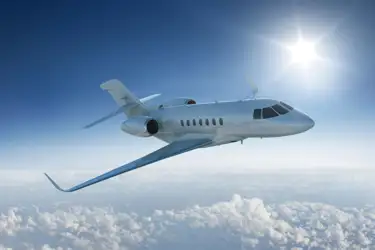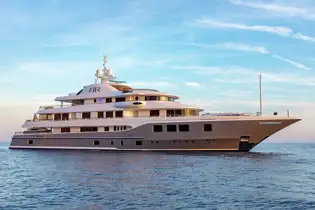 Price reduction on CRAZY – bring offers
Price reduction on CRAZY – bring offers

Winch flies high.
Published 11 février 2022
When Global Jet launched onto the sales market a Boeing 767 with an interior by Winch Design, we had to find out more. We spoke to Jim Dixon, Winch Design's Director of Yachts & Aviation, to get the inside story on the contrasting design opportunities presented by both modes of travel.

B: How different are the challenges of delivering an aircraft interior design to styling interiors for a yacht, the 91.5m Oceanco yacht TRANQUILITY for example?
JD: It's a different environment. On a jet you're confined to that space for a number of hours and your proximity to the interior is very different. You don't get up and walk around as much as you would on a yacht where there's an interior and an exterior experience. On a jet project we work much more closely with the interface between the user and the interior, the functionality and flexibility of the environment.
A jet is somewhat more restrictive in that you can't extend or contract it, it's a finite space, unlike a yacht, which tends to stretch a bit in the project's early stages. An aircraft comes with lots of parameters like safety, airworthiness, restrictions on weight in particular, and those constitute the certification handbook that we have to follow very closely.
There are lots of points in the project we have to go through, like burn testing the all the samples, so we can't use any material we like on a wall or a seat, it has to conform to very strict regulations. We like to use those restrictions as a challenge to our creativity rather than an inhibitor, to think of different ways to solve the problems.
Yachting is probably more regulated and certified that it has been in previous years, with SOLAS regulations and the like. Yachting is approaching the kind of restrictions we have on aircraft but there is still quite a gulf between the two.

Why do clients often choose the same designer for all their assets?
Regardless of the type of project, clients come to us for the same level of quality, detail, creative endeavour and problem solving. They like our versatility, our diversity of design style and that our approach to a project is going to be consistent.
We've done a number of yacht, air and land projects for the same clients, but that's not to say they want a consistency in design style, they often want something very different. We might have done a very classical house interior for a client who wanted something much more contemporary on an aircraft.
It's something that Winch studio is known for, the breadth of its portfolio. Of course it's all about developing a relationship with the client so that they trust you to deliver on whatever design style it might be. The trust factor is the most important.
What was the creative brief for the design and what iterations did the creative go through to reach approval?
It was relatively direct in terms of the design process. The client was a good decision maker and we were equally adept at putting the right solutions in front of them.

Which single design feature embodies the challenges of this design and build?
Twenty years ago - and this was only the second aircraft we had designed - everything was ruled by convention. Everything that had preceded this aircraft and the one we'd done before, followed 40 years of perpetuating the same thing. There was a typical style.
Our designs shook it up somewhat by imparting everything that we'd learned on yachting projects into aircraft. We looked at the space from a completely different perspective, understood how the spaces in the aircraft needn't be so static in their arrangement.
We would have a conversational seating group then you swivel the chair around to the dining table arrangement. As we typically do here in the studio, we really stretch ourselves in terms of analysing the brief, the lifestyle on board the aircraft and what the space could do. That was quite transforming in the result that we came up with.
We're always trying to maximise volume, the impression of space. For instance there is a transparent bulkhead mid-way down the aircraft, which is made of aircraft-grade plexiglass, and it has a Venetian blind in it that rises from bottom to top.
You can look from one space right through to the other, while the blind comes up to create some privacy between one space and the other. It sounds like a very simple thing now, we've done it several times on aircraft, but I think that's the first time I'd ever seen that in an aircraft.

What pleases you most about the outcome of this project?
The client wanted to have a private office in the plane and that's why you see the library with, in the context of an aircraft, two giant, curved, sliding acrylic doors to close it off. The mechanism for those doors was like a Swiss watch, incredibly accurate, because you have to take into account that the aircraft is a dynamic object and in the air it's twisting and flexing, expanding and contracting, all the time. Everything in the interior fit-out has to cope with that movement.
Those sliding doors were quite a feat of engineering and we were very proud when we saw them coming to life. It was nice to see that work out not only in terms of engineering but design-wise it was the right solution for the space and met the client's brief exactly. I know from speaking to the client directly that they really enjoy that area.
On an aircraft project we're always trying to maximise the feeling of volume and space, increasing the sightlines. We have to think about the way you walk through the aircraft, so the geometry of the layout was all in accordance with that. It's also about having a pleasing environment that feels good, natural, uninhibited.

For both yachts and aviation, in terms of sustainability, what changes have you seen in materials and what further changes do you predict?
It's the type of conversation I'm having daily in the studio and with our completion centre partners, how we can focus on aspects of sustainability to do something that's meaningful rather than just pay lip service. It's particularly prevalent in the yachting world at the moment, as it is in general life. It will feed through to aviation projects but for now, as an industry, their focus is on more environmentally friendly fuels and the like, which is also part of the sustainability conversation but at the other end of the landscape.
Some clients are now starting that conversation, which is nice to see. I'm working with a yacht client at the moment whose particular focus is exactly this. From our point of view that makes it a very interesting, enticing project to be involved in because we feel like that can be a platform whereby we can make some traction and really start to say something of purpose. So there are clients who have a strong passion for it and we are trying to harness that and find the right solutions.
It's a real adventure. I recently made one of the interiors team our sustainability champion so her job is solely researching this area to identify sustainable suppliers. We're also working very hard with the Water Revolution Foundation to quantify and benchmark the different sustainability elements, not only of building a yacht, but of operating and maintaining a yacht, then in its afterlife deconstructing and recycling it. It's really interesting stuff.
Our thanks to Jim Dixon of Winch Design for taking time out of an extremely busy schedule to talk to us about the design of this Boeing 767, for sale with Global Jet.
To find out more about Global Jet you can contact them at www.globaljet.aero or +377 97 77 0104.
To find out more about Burgess’ yachts for sale and yachts for charter, please contact a Burgess broker. Alternatively, get in touch with one of our offices directly: London, Monaco, New York, Miami, Singapore or all other locations.
- Yachts, prices and availability are correct at the time of publication.
 Explorer yacht charter: The best places to take a helicopter tour in the world
Explorer yacht charter: The best places to take a helicopter tour in the world
 See you in Aspen this ski season!
See you in Aspen this ski season!
